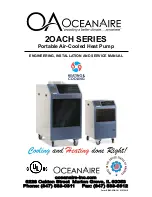
En
gl
is
h (
G
B)
8
7. Installation
Fit the extra nameplate supplied with the pump at the
installation site or keep it in the cover of this booklet.
All safety regulations must be observed at the
installation site, e.g. the use of blowers for fresh-air
supply to the tank.
Prior to installation, check the oil level in the oil
chamber. See section
The SEG pumps are suitable for different installation
types which are described in sections
7.1 Submerged installation on auto coupling
7.2 Free-standing submerged installation
All pump housings have a cast DN 40, PN 10
discharge flange which can also be connected to a
DN 50, PN 10 flange.
7.1 Submerged installation on auto
coupling
Pumps for permanent installation can be mounted on
a stationary auto-coupling guide rail system or a
hookup auto-coupling system.
Both auto-coupling systems facilitate maintenance
and service as the pump can easily be lifted out of
the tank.
Auto-coupling guide rail system
1. Drill mounting holes for the guide rail bracket on
the inside of the tank and fasten the guide rail
bracket provisionally with two screws.
2. Place the auto-coupling base unit on the bottom
of the tank. Use a plumb line to establish the
correct positioning. Fasten the auto coupling with
heavy-duty expansion bolts. If the bottom of the
tank is uneven, the auto-coupling base unit must
be supported so that it is level when being
fastened.
3. Assemble the discharge pipe in accordance with
the generally accepted procedures and without
exposing the it to distortion or tension.
4. Insert the guide rails in the auto-coupling base
unit and adjust the length of the rails accurately
to the guide rail bracket.
5. Unscrew the provisionally fastened guide rail
bracket, fit it on top of the guide rails, and finally
fasten it firmly to the tank wall.
6. Clean out debris from the tank before lowering
the pump into the tank.
7. Fit the guide claw to the discharge port of the
pump.
8. Slide the guide claw down the guide rails and
lower the pump into the tank by means of a chain
fastened to the lifting bracket. When the pump
reaches the auto-coupling base unit, the pump
will automatically connect tightly.
Caution
Prior to installation, make sure the tank
bottom is even.
Warning
Before beginning the installation,
switch off the power supply and lock
the mains switch in position 0.
Any external voltage connected to the
pump must be switched off before
working on the pump.
Note
The pumps are designed for
intermittent operation.
When completely submerged in the
pumped liquid, the pumps can also run
continuously. See section
12. Technical data.
Warning
Do not put your hands or any tool into
the pump suction or discharge port
after the pump has been connected to
the power supply, unless the pump has
been switched off by removing the
fuses or switching off the mains
switch. Make sure that the power
supply cannot be accidentally switched
on.
Caution
We recommend to always use
Grundfos accessories to avoid
malfunctions due to incorrect
installation.
Warning
Only use the lifting bracket for lifting
the pump. Do not use it to hold the
pump when in operation.
Warning
Before beginning installation
procedures, make sure that the
atmosphere in the tank is not
potentially explosive.
Note
Make sure that the pipework is
installed without the use of undue
force. No loads from the pipework
weight must be carried by the pump.
We recommend the use of loose
flanges to ease the installation and to
avoid pipe tension at flanges and bolts.
Note
Do not use elastic elements or bellows
in the pipework; these elements should
never be used as a means to align the
pipework.
Note
The guide rails must not have any axial
play as this would cause noise during
pump operation.






































